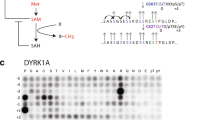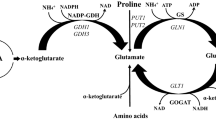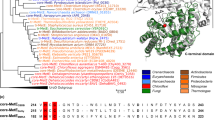Abstract
Previous genetic analyses showed phenotypic interactions between 5-amino-4-imidazole carboxamide ribonucleotide 5′-phosphate (AICAR) produced from the purine and histidine pathways and methionine biosynthesis. Here, we revisited the effect of AICAR on methionine requirement due to AICAR accumulation in the presence of the fau1 mutation invalidating folinic acid remobilization. We found that this methionine auxotrophy could be suppressed by overexpression of the methionine synthase Met6 or by deletion of the serine hydroxymethyltransferase gene SHM2. We propose that in a fau1 background, AICAR, by stimulating the transcriptional expression of SHM2, leads to a folinic acid accumulation inhibiting methionine synthesis by Met6. In addition, we uncovered a new methionine auxotrophy for the ade3 bas1 double mutant that can be rescued by overexpressing the SHM2 gene. We propose that methionine auxotrophy in this mutant is the result of a competition for 5,10-methylenetetrahydrofolate between methionine and deoxythymidine monophosphate synthesis. Altogether, our data show intricate genetic interactions between one-carbon units, purine and methionine metabolism through fine-tuning of serine hydroxymethyltransferase by AICAR and the transcription factor Bas1.





Similar content being viewed by others
References
Ceschin J, Saint-Marc C, Laporte J, Labriet A, Philippe C, Moenner M, Daignan-Fornier B, Pinson B (2014) Identification of yeast and human 5-aminoimidazole-4-carboxamide-1-beta-d-ribofuranoside (AICAr) transporters. J Biol Chem 289:16844–16854
Corton JM, Gillespie JG, Hawley SA, Hardie DG (1995) 5-aminoimidazole-4-carboxamide ribonucleoside. A specific method for activating AMP-activated protein kinase in intact cells? Eur J Biochem 229:558–565
Daignan-Fornier B, Fink GR (1992) Coregulation of purine and histidine biosynthesis by the transcriptional activators BAS1 and BAS2. Proc Natl Acad Sci 89:6746–6750
Daignan-Fornier B, Pinson B (2012) 5-Aminoimidazole-4-carboxamide-1-beta-D-ribofuranosyl 5′-Monophosphate (AICAR), a highly conserved purine intermediate with multiple effects. Metabolites 2:292–302
Denis V, Daignan-Fornier B (1998) Synthesis of glutamine, glycine and 10-formyl tetrahydrofolate is coregulated with purine biosynthesis in Saccharomyces cerevisiae. Mol Gen Genet 259:246–255
Denis V, Boucherie H, Monribot C, Daignan-Fornier B (1998) Role of the myb-like protein bas1p in Saccharomyces cerevisiae: a proteome analysis. Mol Microbiol 30:557–566
Gari E, Piedrafita L, Aldea M, Herrero E (1997) A set of vectors with a tetracycline-regulatable promoter system for modulated gene expression in Saccharomyces cerevisiae. Yeast 13:837–848
Holmes WB, Appling DR (2002) Cloning and characterization of methenyltetrahydrofolate synthetase from Saccharomyces cerevisiae. J Biol Chem 277:20205–20213
Hurlimann HC, Laloo B, Simon-Kayser B, Saint-Marc C, Coulpier F, Lemoine S, Daignan-Fornier B, Pinson B (2011) Physiological and toxic effects of purine intermediate 5-amino-4-imidazolecarboxamide ribonucleotide (AICAR) in yeast. J Biol Chem 286:30994–31002
Kim PB, Nelson JW, Breaker RR (2015) An ancient riboswitch class in bacteria regulates purine biosynthesis and one-carbon metabolism. Mol Cell 57:317–328
Liu X et al (2014) Discrete mechanisms of mTOR and cell cycle regulation by AMPK agonists independent of AMPK. Proc Natl Acad Sci 111:E435–E444
Marie S, Heron B, Bitoun P, Timmerman T, Van Den Berghe G, Vincent MF (2004) AICA-ribosiduria: a novel, neurologically devastating inborn error of purine biosynthesis caused by mutation of ATIC. Am J Hum Genet 74:1276–1281
Narkar VA et al (2008) AMPK and PPARdelta agonists are exercise mimetics. Cell 134:405–415
Pinson B, Merle M, Franconi JM, Daignan-Fornier B (2004) Low affinity orthophosphate carriers regulate PHO gene expression independently of internal orthophosphate concentration in Saccharomyces cerevisiae. J Biol Chem 279:35273–35280
Pinson B, Vaur S, Sagot I, Coulpier F, Lemoine S, Daignan-Fornier B (2009) Metabolic intermediates selectively stimulate transcription factor interaction and modulate phosphate and purine pathways. Genes Dev 23:1399–1407
Rattan R, Giri S, Singh AK, Singh I (2005) 5-Aminoimidazole-4-carboxamide-1-β-d-ribofuranoside inhibits cancer cell proliferation in vitro and in vivo via AMP-activated protein kinase. J Biol Chem 280:39582–39593
Rebora K, Laloo B, Daignan-Fornier B (2005) Revisiting purine-histidine cross-pathway regulation in Saccharomyces cerevisiae: a central role for a small molecule. Genetics 170:61–70
Servant G et al (2012) Tye7 regulates yeast Ty1 retrotransposon sense and antisense transcription in response to adenylic nucleotides stress. Nucleic Acids Res 40:5271–5282
Stover P, Schirch V (1990) Serine hydroxymethyltransferase catalyzes the hydrolysis of 5,10-methenyltetrahydrofolate to 5-formyltetrahydrofolate. J Biol Chem 265:14227–14233
Subramanian M, Qiao WB, Khanam N, Wilkins O, Der SD, Lalich JD, Bognar AL (2005) Transcriptional regulation of the one-carbon metabolism regulon in Saccharomyces cerevisiae by Bas1p. Mol Microbiol 57:53–69
Sullivan JE, Carey F, Carling D, Beri RK (1994) Characterisation of 5′-AMP-activated protein kinase in human liver using specific peptide substrates and the effects of 5′-AMP analogues on enzyme activity. Biochem Biophys Res Commun 200:1551–1556
Tibbetts AS, Appling DR (2000) Characterization of two 5-aminoimidazole-4-carboxamide ribonucleotide transformylase/inosine monophosphate cyclohydrolase isozymes from Saccharomyces cerevisiae. J Biol Chem 275:20920–20927
Acknowledgments
The authors thank Dr F. Lacroute for the gift of the genomic library. H-C. H. was supported by a fellowship from Ligue Nationale contre le Cancer.
Author information
Authors and Affiliations
Corresponding author
Additional information
Communicated by M. Kupiec.
Rights and permissions
About this article
Cite this article
Saint-Marc, C., Hürlimann, H.C., Daignan-Fornier, B. et al. Serine hydroxymethyltransferase: a key player connecting purine, folate and methionine metabolism in Saccharomyces cerevisiae . Curr Genet 61, 633–640 (2015). https://doi.org/10.1007/s00294-015-0489-7
Received:
Revised:
Accepted:
Published:
Issue Date:
DOI: https://doi.org/10.1007/s00294-015-0489-7




